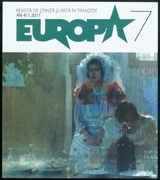Organizarea religios-bisericească a „Ţării Năsăudului” în secolul al XIX-lea
Religius Organization "The Land of Năsăud" in the XIX Century
Author(s): Mirela Popa AndreiSubject(s): Christian Theology and Religion
Published by: Fondul Europa
Summary/Abstract: Starting with the second half of the 18th century, the “Land of Năsăud” had developed a specific, clearly-cut identity. It had a strong idea which was strengthened by the events occurred at the end of the century, as well as during the next one. The inhabitants of the region under survey had enjoyed the status of free men as early as the Middle Ages. So, the setting up of the second Romanian border regiment, whose main purpose was the improvement of their social, economic and cultural status, accelerated the process of particularization of the “Land of Năsăud” within the Transylvanian Principality. The majority of the region’s population was Romanian and followed the Orthodox religion. When Austrian government was set up here, Catholicism started to gain territory. Since the military was required here anyway it was also used to encourage the consolidation of the Greek-Catholic Church, Austrians decided to establish two Romanian border regiments, the second one having its headquarter in Năsăud. At the same time, the Romanian Greek-Catholic Church of Transylvania the first three vicarages were set up at he end of 18th century (Rodna, Făgăraş and Haţeg). The institution of the vicarage was superior to that of the protopope by authority, and played a major role not only in monitoring and defending the religious union, in training the clergy and the people, but also in "developing" the "United" Church by gaining new followers. This was the result of an original mixture of institutional parts from the Roman-Catholic, Orthodox and Calvinist Churches. The vicarage of Rodna was initially included within its boundaries 39 communities from 44 villages of the “Land of Năsăud” which established the second Romanian border regiment. After 1851, following the dissolution of the border regiment system, nine parishes were separated from the vicarage. This illustrated the intention of the high church authorities to make religious administration more efficient. So, they established Budacul Român which remained in a subordinate jurisdictional-ecclesiastic position to the vicarage of Rodna.
Journal: Europa, revistă de literatură, artă, cultură şi tranziţie
- Issue Year: 2011
- Issue No: 07
- Page Range: 112-117
- Page Count: 6
- Language: Romanian

